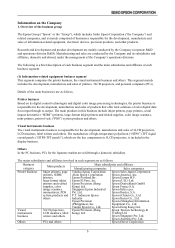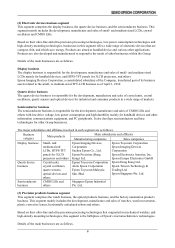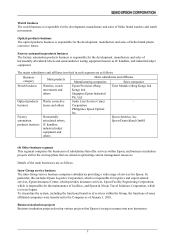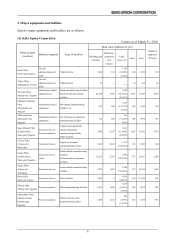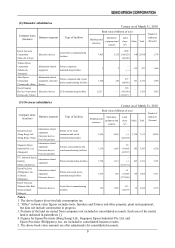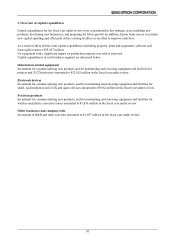Epson 2010 Annual Report Download - page 16
Download and view the complete annual report
Please find page 16 of the 2010 Epson annual report below. You can navigate through the pages in the report by either clicking on the pages listed below, or by using the keyword search tool below to find specific information within the annual report.
15
sales, social, political or economic changes, transport delays, damage to infrastructure (e.g., power supply),
restrictions on currency exchanges, insufficient skilled labor, changes in regional labor environments, changes
in taxes, regulations or the like protective of trade, and laws, ordinances, regulations, or the like related to the
import and export of Epson products.
9. The intense technological innovation required of Epson entails risks
Epson is engaged in manufacturing and selling products that require advanced technologies, so technological
superiority is a vital element of Epson’ s competitiveness. Epson possesses core technologies—for example,
ultra-fine, ultra-precise processing technologies, low-power consumption technologies, thin-film technologies,
surface treatment technologies, high-density mounting technologies, digital control technologies and digital
color image processing technologies. By evolving and fusing these technologies, Epson has been able to
manufacture and sell products that meet customers’ needs, thereby developing the presence that it has today.
The rate of technological innovation required in most of the fields in which Epson is engaged, however, is so
intensely fast, that in order to respond swiftly to customer needs in the face of changes in technology, Epson
sometimes must undertake long-term investments or capital spending based on product predictions. Thus, while
Epson is making every effort to gauge market and customer needs and will maneuver to respond to the intense
technological innovation on which they depend, if Epson is unable to accurately gauge those market trends or
customer needs, it may not be able to appropriately respond to the required technological innovations, and its
results might be adversely affected.
10. The short lifecycle of certain products makes Epson vulnerable to certain risks
Epson is manufacturing and selling products that generally have short life cycles, such as consumer products.
Epson has its own group distribution network throughout the world and is taking various measures, such as
trying to understand through its distribution subsidiaries and branches the needs for different products in each
region, and striving to reduce lead time by establishing production sites in regions close to consumers. If the
transitions from existing products to new ones do not go smoothly, however, Epson’ s results could
consequently be adversely affected.
Factors affecting whether the transition to a new product goes smoothly include delays in the development or
production of Epson’ s new products, competitors’ timing in introducing their new products, the difficulty in
predicting changes in consumers’ needs, a decline in purchases of existing products as consumers anticipate
new product introductions, and competition between Epson’ s existing and new products.
11. Procuring products and outsourcing the manufacture of products entails risks for Epson
Epson procures parts, semi-finished products and finished products from third parties, but it has generally
conducted transactions without entering into any long-term purchase agreements. Epson is developing upon its
efficient procurement activities by cooperatively engaging with such suppliers in maintaining product quality,
improving products and reducing costs. However, if its ability to procure was to be adversely affected by, for
example, insufficient supply from a third party, poor quality of products supplied or the like, then Epson’ s
results could consequently be adversely affected. Epson strives to, in principle, procure parts and the like from
multiple suppliers, but there are some cases in which it can only procure parts from one company due to the
difficulty of procuring an alternative component from another company. One such example is actuators, which
are the primary component of the print heads in medium- and low-price inkjet printers. On the manufacturing
side of its business, Epson outsources the manufacturing of certain products such as inkjet printers. If demand
for such products rises suddenly, it will become difficult to secure alternative or additional manufacturers to
outsource to, and Epson might become vulnerable to such risks as an increase in costs or a delay in production.
12. Epson faces risks concerning the hiring and retention of personnel
It is vital that Epson hire and retain talented personnel both in Japan and overseas for the development and
manufacture of Epson’ s advanced new technologies and products, but the competition for recruiting personnel
is becoming increasingly intense. Epson is putting considerable effort into securing talented personnel by
establishing research and development sites and design sites both in Japan and overseas. If Epson is unable to
continue to use or employ an adequate number of talented personnel, however, the implementation of its
business plans could be adversely affected.


